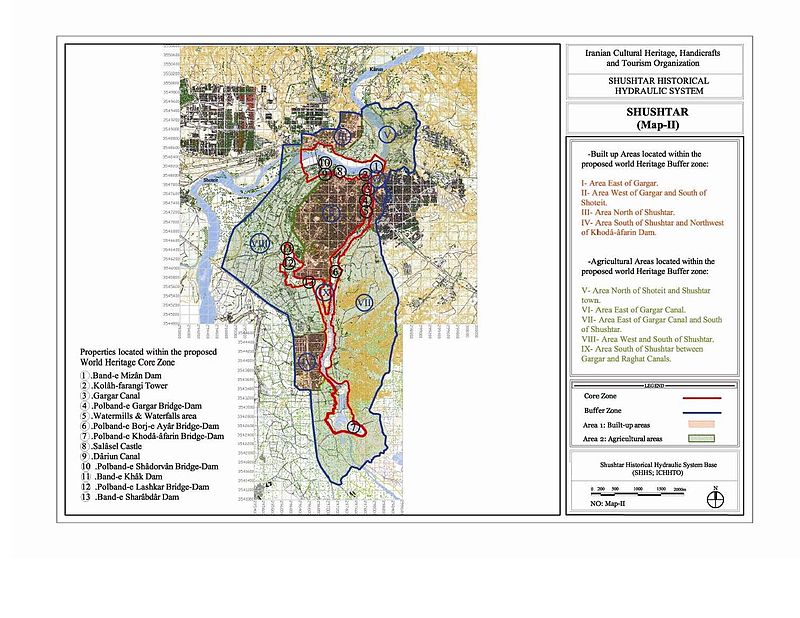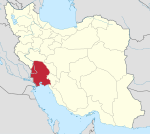Shushtar Historical Hydraulic System
You can help expand this article with text translated from the corresponding article in Persian. (October 2015) Click [show] for important translation instructions.
|
| UNESCO World Heritage Site | |
|---|---|
| Location | Shushtar County, Khuzestan Province, Iran |
| Reference | 1315 |
| Inscription | 2009 (33rd Session) |
| Area | 240.4 ha (594 acres) |
| Buffer zone | 1,572.2 ha (3,885 acres) |
| Coordinates | 32°02′39″N 48°51′31″E / 32.0441°N 48.8585°E |
The Shushtar Historical Hydraulic System (Persian: سازههای آبی شوشتر) is a complex irrigation system of the island city Shushtar from the Sassanid era. It consists of 13 dams, bridges, canals and structures which work together as a hydraulic system.
Located in Iran's Khuzestan Province.[1] It was registered on UNESCO's list of World Heritage Sites in 2009 and is Iran's 10th cultural heritage site to be registered on the United Nations' list.[2]
This engineering masterpiece is unique both in Iran and in the world. The Sassanids, whose economy was mainly dependent on agriculture, developed extensive irrigation systems in this region.[3]
Infrastructure included water mills, dams, tunnels, and canals. Gargar Bridge-Dam was built on the watermills and waterfalls. Bolayti canal is situated on the eastern side of the water mills and water falls and functions to supply water from behind the GarGar bridge to the east side of water mills and channel the water to prevent damage to the water mills. Dahaneye shahr tunnel (city orifice) is one of the three main tunnels which channeled the water from behind the Gargar Bridge-Dam into the water mill and then run several water mills. Seh kooreh canal channels the water from behind the GarGar bridge into the western side. In the water mills and water falls, we can see a perfect model of haltering to run mills.[2]
The Band-e Kaisar ("Caesar's dam"), an approximately 500-metre (1,600 ft) long Roman weir across the Karun, was the key structure of the complex which, along with the Mizan Dam (Band-e Mizan), retained and diverted river water into the irrigation canals in the area.[4] Built by a Roman workforce in the 3rd century AD on Sassanid order,[5] it was the most eastern Roman bridge and Roman dam[6] and the first structure in Iran to combine a bridge with a dam.[7]
Parts of the irrigation system are said to originally date to the time of Darius the Great, an Achaemenian king of Iran. It partly consists of a pair of primary diversion canals in the Karun river, one of which is still in use today. It delivers water to the Shushtar city via a route of supplying tunnels.[citation needed] The area includes Salasel Castle, which is the axis for operation of the hydraulic system. It also consists of a tower for water level measurement, along with bridges, dams, mills, and basins.[2]
Then it enters the plain south of the city, where its impact includes enabling the possibility of farming over the area called Mianâb and planting orchards.[2] In fact the whole area between the two diversion canals (Shutayt and Gargar) on Karun river is called Mianâb, an island having the Shushtar city at its northern end.[8]
The site has been referred to as "a masterpiece of creative genius" by UNESCO.[9]
Sites
[edit]Shushtar Historical Hydraulic System is a complex of dams, bridges, canals and structures which consists of 13 sites which work together as a hydraulic system.[10][11]
1. Mizan Dam
2. Kolah-Farangi Tower
3. Gargar Canal
5. Watermills and Waterfalls area
6. Borj Ayar Bridge-Dam and Sabein Sanctuary
7. Khoda-Afrain Bridge-Dam
9. Dariun Canal
11. Band-e Khak Dam
12. Lashkar Bridge-Dam
13. Sharabdar Dam
Gallery
[edit]References
[edit]- ^ Shushtar Archived 4 June 2010 at the Wayback Machine, world heritage sites, retrieved on 1 May 2010.
- ^ a b c d Shushtar Historical Hydraulic System, UNESCO, Retrieved on 1 May 2010.
- ^ followinghadrian (24 October 2020). "Shushtar". following hadrian photography. Retrieved 4 January 2023.
- ^ Length: Hodge 1992, p. 85; Hodge 2000, pp. 337f.; extensive irrigation system: O'Connor 1993, p. 130
- ^ Smith 1971, pp. 56–61; Schnitter 1978, p. 32; Kleiss 1983, p. 106; Vogel 1987, p. 50; Hartung & Kuros 1987, p. 232; Hodge 1992, p. 85; O'Connor 1993, p. 130; Huff 2010; Kramers 2010
- ^ Schnitter 1978, p. 28, fig. 7
- ^ Vogel 1987, p. 50
- ^ C. J. Edmonds, East and West of Zagros, BRILL, 2009, ISBN 9004173447; Page 157.
- ^ Check out 13 emerging wonders of the world, msn news, Retrieved on 1 May 2010.
- ^ Centre, UNESCO World Heritage. "Shushtar Historical Hydraulic System". UNESCO World Heritage Centre.
- ^ "Shushtar Hydraulic System (Iran)". Archived from the original on 10 February 2017.
Sources
[edit]- Hartung, Fritz; Kuros, Gh. R. (1987), "Historische Talsperren im Iran", in Garbrecht, Günther (ed.), Historische Talsperren, vol. 1, Stuttgart: Verlag Konrad Wittwer, pp. 221–274, ISBN 3-87919-145-X
- Hodge, A. Trevor (1992), Roman Aqueducts & Water Supply, London: Duckworth, p. 85, ISBN 0-7156-2194-7
- Hodge, A. Trevor (2000), "Reservoirs and Dams", in Wikander, Örjan (ed.), Handbook of Ancient Water Technology, Technology and Change in History, vol. 2, Leiden: Brill, pp. 331–339, ISBN 90-04-11123-9
- Huff, Dietrich (2010), "Bridges. Pre-Islamic Bridges", in Yarshater, Ehsan (ed.), Encyclopædia Iranica Online
- Kleiss, Wolfram (1983), "Brückenkonstruktionen in Iran", Architectura, 13: 105–112 (106)
- Kramers, J. H. (2010), "Shushtar", in Bearman, P. (ed.), Encyclopaedia of Islam (2nd ed.), Brill Online
- O'Connor, Colin (1993), Roman Bridges, Cambridge University Press, p. 130 (No. E42), ISBN 0-521-39326-4
- Schnitter, Niklaus (1978), "Römische Talsperren", Antike Welt, 8 (2): 25–32 (32)
- Smith, Norman (1971), A History of Dams, London: Peter Davies, pp. 56–61, ISBN 0-432-15090-0
- Vogel, Alexius (1987), "Die historische Entwicklung der Gewichtsmauer", in Garbrecht, Günther (ed.), Historische Talsperren, vol. 1, Stuttgart: Verlag Konrad Wittwer, pp. 47–56 (50), ISBN 3-87919-145-X
External links
[edit]- Livius.org: Shushtar Archived 23 December 2012 at the Wayback Machine
- UNESCO: World heritage site
























